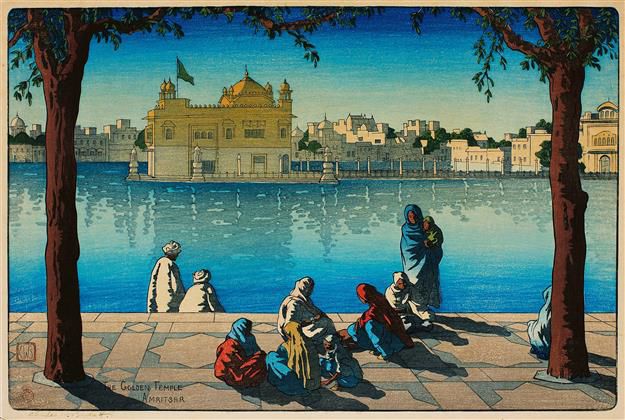India, by foreign artists
Malvika Kaul
It was in the mid-19th and early 20th centuries when close to 40 foreign artists travelled to India and painted not just the grandeur of palaces, but the noise and movement of Indian streets. Coming from Germany, Italy, America, Japan and Britain, they captured the calmness amidst the chaos of the ghats of Benaras, the quaint potsellers waiting for customers, a water donor quenching the thirst of many, and the vibrant banjaras (gypsies) setting up camp. These artists left behind treasures, many of which the art company DAG is showcasing at its gallery in New Delhi until August 24.
The exhibition, ‘Destination India: Foreign Artists in India, 1857-1947’, offers an intimate look at an India that you can almost hear, feel and smell. Schools, homes, marketplaces, street performances, funerals, festivals, workshops and riverside scenes come alive in the water colours, etchings and oil canvases on display. Many of these artists — William Simpson, Olinto Ghilardi, Marius Bauer, Erich Kips, Edwin Lord Weeks and Hiroshi Yoshida — came to India when photography was emerging as a dominant art.
Thanks to earlier remarkable painters like William Hodges and Thomas Daniel and his nephew William Daniel, Indian monuments like the Taj Mahal were no longer unknown masterpieces. But, after the uprising against the British in 1857, India was in the news again. It needed to be re-explored, more deeply, more closely. Several of the foreign artists attempted to do so. Their works are significant as they do not fit into the traditional colonial images of majestic monuments and spaces that bedazzled the foreigners.
Ashish Anand, CEO and managing director of DAG, writes in the note on the exhibition that these artists “came to India with a different aesthetic sensibility and with different interests”. They were more interested in “living India”, in the daily routine of the bazaars and havelis. What they created was “a more animated and picturesque aesthetics”. With this show, DAG attempts to shift the focus of British and other European representations of India to works that appeared to have a more nuanced eye for the Indian subcontinent.
Italian painter Olinto Ghilardi (1848-1930) came to Calcutta to teach art and mentored Abanindranath Tagore, nephew of Rabindranath Tagore, famous for the work ‘Bharat Mata’. Ghilardi is known to have encouraged young Indian artists and influenced the Bengal School of Art. His works at the show speak about his artistic prowess. In the remarkable pastel on paper ‘Portrait of Elderly Indians’, Ghilardi captured both the frailty of old age and the capacity to connect with the spiritual. The three men are old, but not tired to undertake another journey.
Japanese artist Hiroshi Yoshida (1876-1950) was a remarkable woodblock printmaker. In 1930, he took trips to India, China, Egypt and Canada. He was especially impressed by the quality of light in India. Among his many beautiful works on display is ‘Shalimar Garden, Lahore’, a woodblock print on paper that is a wonderful blend of the western tradition of oil paintings and Japanese visual art. Some of his works like ‘A Gate to the Stupa of Sanchi’ and ‘No. 3 Cave Temple in Ellora’ give a historical perspective, while others like ‘Caravan from Afghanistan’ detail life in the early 20th century for merchants and traders.
A stunning watercolour, ‘Jumma Masjid, Delhi’, by William Simpson (1823-1899) almost appears like a visual taken by a drone. The panoramic view of this famous monument tells several stories: Old Delhi was not so crowded, the bazaars had not engulfed the monument and people used palanquins and horses to move around. Simpson was a war artist and lithographer. He came to India in 1859 to “illustrate the country” after the 1857 uprising. The company that hired him went bankrupt, but Simpson stayed on and produced an extraordinary body of work, illustrating ordinary people and their environs. In ‘The Brindjarries’, Simpson creates a realistic portrayal of the banjaras. The women in the picture wear colourful attire and elaborate jewellery and appear to be settling down at the end of the day.
Many of the works on display are from DAG’s own collection. A few have been loaned for the exhibition. The purpose of the show has been to expand the narrative of Orientalist paintings. Edward Lear (1812-1888), who toured India between 1873 and 1875, witnessed a country that was both blending and clashing with western thoughts and ideas. He visited Delhi, Kanpur, Lucknow, Benaras, Calcutta, Darjeeling and explored the hill stations of Ooty, Shimla and Coonoor. His work ‘The British Residency, Lucknow’ evokes a chilling response to the terrible violence during the 1857 uprising.
For many artists, India was a place to meander. Some got lost in its colours and costumes, while others savoured its diverse landscapes. In British artist Charles William Bartlett’s (1860-1940) various works on display, including an enchanting one of the Golden Temple, one finds the essence of such explorations: people of India were their artistic destination.









